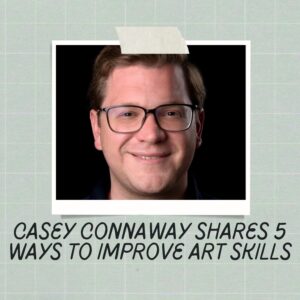Art is an activity that’s important in many different fields, whether you’re a graphic designer, an architect, or just someone who enjoys painting or sculpting for fun. There are also plenty of artists out there who are just starting out and want to improve their skills so they can create the art they want to make. If you fall into this category, you’ll find Casey Connaway’s tip for your art skills.
Professional artist Casey Connaway has spent years honing his art skills, and he’s worked with students of all ages and experience levels to help them improve their own art. He’s shared 5 ways that every artist can learn how to improve their art skills without spending years practicing drawing the same thing over and over again. If you’re looking to improve your own art, check out the advice from this professional artist
Think Before You Ink
While it may seem like an art project is all about just getting out there and trying something, it’s important that you think before you ink. Approach your art with a plan and have a vision in mind. If you’re not sure what idea you want to use or if you don’t know where your piece will take you, start by brainstorming ideas. This way, when inspiration hits or once your creative energy peaks, you can hit record mode on that vision right away!
Try Not to Overwork the Drawing
Drawing is all about control, which starts with making sure you’re in total control of your drawing and not letting it take over. Get used to putting as much time into each stroke as possible and don’t try too hard for perfection; instead, embrace happy accidents and embrace your mistakes. When you feel good about what you’ve done, but are still willing to try different things (experiment), that’s when your drawings will look their best.
Be Organized as Possible
There’s nothing worse than starting a project, realizing you have all of the wrong materials, and needing to make a trip back to an art store before you can get any real work done. To avoid that scenario and be as organized as possible, take stock of everything you have on hand. List every single thing you own that might be remotely related to art. It may seem like overkill, but making sure you know exactly what supplies you already have, will make shopping much easier and if there are things on your list that aren’t currently in use but might one day come in handy, it could save you time later.
Enjoy Every Step of the Process
Casey Connaway, an artist and designer, knows firsthand how beneficial working on your art can be. I’ve never been much of a planner or goal-oriented person. But when it comes to my art I am very process-oriented, he says. I tend to lose focus on what I need to get done if I’m not enjoying every step of the process. Casey has focused on improving his skills in different mediums over time, pushing himself forward by trying out new challenges and experiments with subject matter and technique. When you make creating your art a priority in life, rather than something you do as part of another activity, it gives you more ownership of that piece in a way that is special to you. His advice?
Study Other Artists
Although we don’t always have time for formal art training, studying other artists is an excellent way to improve your own techniques. Watching YouTube videos and keeping an eye on art blogs are a couple of ways you can do so!
- caseyconnawayus@gmail.com
- https://soundcloud.com/caseyconnaway
- General
- United States









